2.11., 03.11.
The wind was taking control the last 1,000 kilometers towards the Chilean border. I got a bit scared, how much the side- and headwinds impact on fuel consumption. At 290 km the reserve light flashed. I started to count: 290 km, 13.3 liters, that is about 4.6 liters per 100km, compared to 3.5 on average. My GPS showed a gas station in 109km. I have 4 liters reserve. It does not take a mathematician to see that there could be a problem. Going back? The last gas station was around 30km back. I reduce the speed and move on. Luckily they put a village somewhere in between where I can refill.
The wind is a constant unpredictable enemy against whom you fight. Sometimes you get pushed down or the wind suddenly vanishes when you lean against it.
The endless straight streets in the desert are interrupted by smaller and larger villages. They are like islands in a sea of sand. Where rivers made their way through the mountains in hundreds of thousands of years, there are green oases.
It’s early in the afternoon, so I decide to cross the border to Chile. The border formalities are done soon. Only the two apples that I have stored in my bag are responsible for a delay. My bags get x-rayed. You are not allowed to import fresh food. I have to fill out a form. The two apples got weighed, everything was entered in the computer and then they got disposed in the trash.
Peru was sometimes a real challenge, up in the high cold mountains and with the winding roads. I’m curious what Chile has prepared for me.
Chile:
The penultimate country on the way south. There is a time jump forward by two hours. That means, it gets dark two hours later. I get a bit confused in the first days, because I was used that it is dark around 7pm.
Arica is just across the border, where I spend the first night. Chile is pretty expensive, prices are European.
04.11.
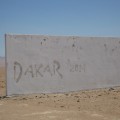 Desert, desert, Atacama Desert. Heaps of sand up in the north of Chile. A giant cat toilet. Gas stations are pretty rare up here – it gets better more south. With the last drop of gas I arrive in Iquique. Iquique is located at about 600m above sea level. The road down offers a breathtaking view of the city, which is dominated by a huge sand dune.
Desert, desert, Atacama Desert. Heaps of sand up in the north of Chile. A giant cat toilet. Gas stations are pretty rare up here – it gets better more south. With the last drop of gas I arrive in Iquique. Iquique is located at about 600m above sea level. The road down offers a breathtaking view of the city, which is dominated by a huge sand dune.
I can hardly believe it. Finally I got distilled water for my battery in a hardware store. Yes, a hardware store. Since the U.S. I have not seen a hardware store. I’ve already been wondering that the battery has not made any problems. I pour about 1/8l water into the battery.
How many times have I asked in motorcycle shops and battery shops. The last one in Peru wanted to sell me battery acid. Whenever I said, I need water for my battery, they looked dumb at me. Distilled water .. unknown. Especially in Central and South America, where so manypeople have motorbikes. I did not understand that.
I also got Ducttape at the hardware store. A buddy once wrote “Ducttape fixes everything”. I’m curious, if I can fix the holes in my panniers.
05.11.
Day 2 in Iquique. Working day. I spend almost 4 hours via remote access to update a few computers at home. I’m not here for pleasure. :-) A little chat with family and friends. You have to take advantage of a fast Internet connection.
Having lunch and doing some sightseeing. I got in contact with BMW in Valparaiso. A service needs to be done. My lady demands a new rear shoe and she is crying for some other care.
06.11.
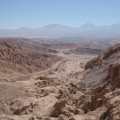 About 500km to San Pedro de Atacama. A lot of tourists here. Like 20 to 1 compared to local people. The village is in the middle of nowhere. There are some sights around the area. I got a bed in a dorm for one night, after asking through several hostels. Anyway it was too touristy for me.
About 500km to San Pedro de Atacama. A lot of tourists here. Like 20 to 1 compared to local people. The village is in the middle of nowhere. There are some sights around the area. I got a bed in a dorm for one night, after asking through several hostels. Anyway it was too touristy for me.
In Peru, I met three dutch motorcyclists somewhere on the road. They told me, that they belong to a group of 27 people who are traveling for 50 days on an organized tour from Ecuador to Punta Arenas. As I walk through San Pedro, I see them all in a hostel.
07.11.
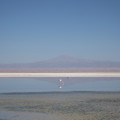 In the morning I go to the Salar de Atacama, a salt lake about 40km from San Pedro, where I am supposed to see flamencos. There are a few actually in the water surrounded by a bizarre landscape. After that, I’m move on to Antofagasta. Sometimes I fall asleep for several minutes on those long straight roads.
In the morning I go to the Salar de Atacama, a salt lake about 40km from San Pedro, where I am supposed to see flamencos. There are a few actually in the water surrounded by a bizarre landscape. After that, I’m move on to Antofagasta. Sometimes I fall asleep for several minutes on those long straight roads.
Mining is the dominant industry in the Atacama. Many street signs indicate the direction to mines. Some signs have information about historic mines and settlements on it. Some of them date back about 150 years. Sometimes ghost villages are seen off the Panamericana. Often the houses are gone, only the cemeteries are still present, where the iron crosses are rusting in the bright sun.
Antofagosta is far away from beeing a nice city There are many Titty Bars in the city – “Girls and Beer”. Probably to get the money out of the miners pockets.Walking to the center, I got stopped by a seedy man. He speaks perfect English and has only a few teeth in the mouth. Told me that he wants no money, only practice English. He has lived 10 years in the U.S., but unfortunately no one here speaks English and he is happy when he can practice a little bit. He told me how prosperous Chile is, because they have copper. With him, this prosperity has not arrived yet. He repeatedly emphasized that he wants no money, but we could go and have a beer … I’m moving on.
08.11.
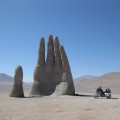 No change in sight. Desert as far the eye can see.
No change in sight. Desert as far the eye can see.
I was already very impressed of the Australian Outback, but the Atacama represents a new dimension. For days I just drive through desert, between 400 and 500 km a day, which is pretty tedious. Maybe I go in circles, but I don’t think so, when driving down the long straight roads.
Before Caldera, I go through the National Park Pan de Azucar and drive the last 100km along the coast. Finally there is some change.
Chile is very expensive – especially hotels – European prices. I was used to get along with about 30 EUR per day in Central and, so far, in South America until now – eating, gas, accommodation included. Here I need much more.
09.11.
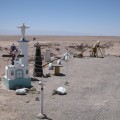 In a cloudy and cold weather I made my way to La Serena.
In a cloudy and cold weather I made my way to La Serena.
The Pan-American Highway has claimed many victims. It almost looks like a long cemetery. The dead are honored with memorials that are sometimes made very creative. But the whole Panamericana is renovated. A large part of the Pan-American Highway in Chile is in new excellent condition. In one to two years you can go through Chile with a Formula 1 car.
Who thought that it is warm here, is wrong. It takes until about 10:30 until the sun is winning the fight above the haze. Until then, it’s freezing cold. It is more warm further inland, where the mountains start to raise, between 2,000 and 2,500 m above sea level. It’s hot when you don’t move, but driving, it is very cold. It get’s much colder when you get close to the sea. I almost always wear sweaters, warm lining and face mask.
After driving about 3,000 km in the last 7 days, I have a stopover for three nights in La Serena.
10.11.
Good morning. I am happy that I don’t have to get up. And it is raining, so I even don’t have to look for an excuse.
Thank you for reading, Juergen.
This time in the gallery:
– Endless Roads
– Faces of the Desert
– Worshipping the dead
– … and other things


Leave a Reply